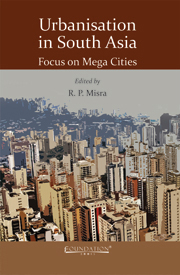Book contents
- Frontmatter
- Contents
- List of Figures
- List of Tables
- List of Contributors
- Introdution
- 1 South Asia: Land, People, and Economy
- 2 Historical Roots of South Asian Urbanisation
- 3 Mumbai: The Financial Capital of India
- 4 Delhi: Growing Problems of a Growing Megalopolis
- 5 Calcutta: The Emergence of Colonial Settlement into Megacity of the East
- 6 Chennai: A Rural Metropolis in Search of Modernity
- 7 Hyderabad: From the Feudal City to a Hi-Tech Metropolis
- 8 Bangalore: From Garden City to Silicon Valley of India
- 9 Karachi: The Commercial Capital of Pakistan
- 10 Lahore: The Cultural Heart of Pakistan
- 11 Kabul: A City in Perpetual Turmoil
- 12 Dhaka: A Mega City of Persistence and Change
- 13 Kathmandu: A City Where Tradition and Modernity Overwhelm Each Other
- 14 Thimphu: The City of Peace and Organic Development
- 15 Colombo: The Primate City of Sri Lanka
- 16 Male: Island Capital of an Island Nation
- 17 Beyond the Present: Vision of a New Urban Future
- Index
11 - Kabul: A City in Perpetual Turmoil
Published online by Cambridge University Press: 05 September 2013
- Frontmatter
- Contents
- List of Figures
- List of Tables
- List of Contributors
- Introdution
- 1 South Asia: Land, People, and Economy
- 2 Historical Roots of South Asian Urbanisation
- 3 Mumbai: The Financial Capital of India
- 4 Delhi: Growing Problems of a Growing Megalopolis
- 5 Calcutta: The Emergence of Colonial Settlement into Megacity of the East
- 6 Chennai: A Rural Metropolis in Search of Modernity
- 7 Hyderabad: From the Feudal City to a Hi-Tech Metropolis
- 8 Bangalore: From Garden City to Silicon Valley of India
- 9 Karachi: The Commercial Capital of Pakistan
- 10 Lahore: The Cultural Heart of Pakistan
- 11 Kabul: A City in Perpetual Turmoil
- 12 Dhaka: A Mega City of Persistence and Change
- 13 Kathmandu: A City Where Tradition and Modernity Overwhelm Each Other
- 14 Thimphu: The City of Peace and Organic Development
- 15 Colombo: The Primate City of Sri Lanka
- 16 Male: Island Capital of an Island Nation
- 17 Beyond the Present: Vision of a New Urban Future
- Index
Summary
Kâbul, the capital and largest city of Afghanistan, is the economic and cultural hub of the country. Located on the Gateway to the ‘Fabulous East’, the tribal columns from Central and West Asia have occupied, passed through and trampled the city many a time. However, the worst times it witnessed was the Taliban Era (1978-2003), not because some foreign invaders trampled over it, but because its own people, the Afghans turned Mujahideens, turned Taliban, left nothing intact, not even minds and souls of the people. Here is an account of what I read about the city and what I saw during my visits during 2007-09.
Since 1978, Afghanis have been fighting against external forces as much as among themselves. Being the capital city, Kabul had to bear the destruction caused by marching armies and exploding bombs. The Mujahideen, the protectors of the faith, eventually succeeded in taking control of the country from Russian hands in 1992. Mohammad Nazibullah, the then pro-USSR president of the country, fearing capture and execution, took shelter in the UN Mission building. Taliban, the Millitia of Islamic Students, subdued other factions of the Mujahideen and gained control over Kabul in 1996. Najibullah was forcibly taken away from the UN Mission and executed in an open pavilion. The Taliban practiced a radical form of Sunni Islam that took strict stances on women, society, and even other sects of Muslims. They ruled over Afghanistan with an iron fist until their ouster by the American forces in 2001.
- Type
- Chapter
- Information
- Urbanisation in South AsiaFocus on Mega Cities, pp. 315 - 340Publisher: Foundation BooksPrint publication year: 2012



